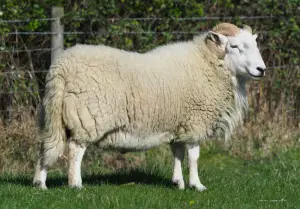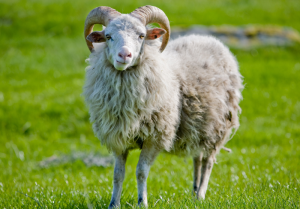Do Sheep Have Horns?
Sheep are believed to have been among the first animals domesticated by humans. In the thousands of years since domestication, hundreds of different breeds have been developed to provide humans with meat, milk, and wool. If you’ve had limited experience with sheep farms, you may be wondering whether or not sheep have horns.
Do sheep have horns? Whether or not a sheep has horns will depend largely on its breed. Many breeds of sheep do have horns, like their wild ancestors – the most commonly found wild sheep being called, literally, the “Bighorn”. Many breeds do not have horns, and are therefore referred to as naturally “polled” (or, hornless).
Sheep are unique among horned animals in that their horns are like works of art – large, thick, and beautifully spiraled. There is a lot to learn about these beautiful specimens, including with what material they are made and why some sheep have been bred to be naturally polled.
Which Breeds Of Sheep Have Horns?
Wondering where some of the most commonly found sheep breeds stand in terms of horn possession? Here are some of the most popular breeds of sheep:
Merino – The Merino breeds (including the Rambouillet) account for around half of the world’s sheep population. There are multiple variants of the Merino, with some being naturally polled, and some variants having horned rams.
Suffolk – Suffolk sheep of both sexes are naturally polled.
Katahdin – While some Katahdins have horns or scurs (undeveloped horns), most Katahdins of both sexes are naturally polled.
Dorper – Similarly to the Katahdin, most Dorpers of both sexes are naturally polled, while few rams will be born with horns or scurs.
Dorset – Dorsets come in both horned and polled varieties. In the horned variants, both sexes may be horned, with the rams possessing impressive, spiraled horns.
Should Sheep Be De-Horned? 
If you would like a breed of sheep without horns, it is best to focus on a naturally polled breed. These sheep have been bred throughout the years for the absence of horns and aside from the outlier, will be born as lambs without any need for disbudding or dehorning.
If you breed a non-polled breed of sheep and you want to remove the horns, it is best to do this as young as possible – within the first week is preferred. At this young age you will find that your lambs have horn “buds”. To dis-bud your lamb, you will need to use a disbudding iron. This is a hot rod (or, iron), that you place on top of the bud.
The rod will burn a ring around the bud, after which you will pick off the bud and use the side of the rod to cauterize the wound. After you are finished, it is best to bring the lamb back to her ewe so that she can seek comfort and nurse. If this sounds painful, it is. Fortunately, lambs are resilient, and can often be found playing and frolicking shortly after the procedure.
If you have an older lamb (or sheep) and would like to remove the horns, you will need to contact a veterinarian. The bones of the horns are securely attached to the sheep’s skull, and removing fully (or even partially) developed horns is a major operation. The animal is put under general anesthesia and the skull and sinus cavities will have to be opened. This is not a procedure that is often done, and is typically only considered under extreme circumstances.
The Anatomy Of The Sheep Horn
Sheep horns consist of a bone that will extend out of the head but will not fill the entire length of the horn. Encompassing this bone is a sheath made of keratin – a protein that is also the substance of hooves, fingernails, and hair. While the keratin sheath cannot feel pain or bleed, the horn itself is “living” and has nerve endings and a blood supply. The portion of the sheath beyond the bone is hollow.
While most (but not all) will curl back and away from the head, sheep horns come in a variety of sizes, shapes, and spiraling designs. Some breeds of sheep have both horned males and horned females, while in other breeds only the males are horned. In the latter case, wethers will remain polled like the ewes. And finally, in other breeds, the horns have been bred out of the sheep completely.
Why Are Polled (Hornless) Sheep Often Preferred?
There are three main commodities for which sheep are raised – their meat, their milk, and their wool. Not only are horns unnecessary for the production of these products, but they can actually hinder the safety of the animals (and handlers). For this reason, many sheep have been bred over the years to be naturally polled. Horns can become a nuisance in the following circumstances:
Sheep Horns Can Cause Injury To Others
The most obvious reason that sheep horns may be considered a nuisance is because they can cause harm to both humans and other sheep. The concern is not necessarily the sharp ends (though these may be worrisome in some situations) – unlike with goats, a sheep’s horns will curve backward, limiting the ability to gore others with their horns.
The horns are, however, very strong. The sheep’s defense is its ability to headbutt with incredible force. While polled sheep can certainly still headbutt, the furry skull is somewhat less intimidating than a full set of horns.
Sheep Horns Can Cause Property Damage
Those big, strong horns are not only a concern for other living creatures – sheep have also been known to damage equipment, fences, and even property with their horns. Many fences, particularly, are of little match to a battering ram’s horns.
Sheep Horns Can Become Stuck
Most concerning to many sheep farmers is the ability of the horns to become stuck – stuck in fencing gaps, stuck in branches, stuck in wire. If a sheep is immobile for too long, he will be at risk of dehydration and of becoming a victim to the elements or to predators.
Even if an immobilized sheep is found and rescued quickly, he will have suffered significant anxiety and panic over his situation. Becoming stuck in any unmanaged situation is especially dangerous for a sheep.
Sheep Breeds With Trophy Horns 
While most farm breeds have been altered over the years to remove the horns, other breeds have been altered over the years to improve them. These sheep are bred as “trophy sheep” – hunted and prized for their impressive horns.
The Corsican breed of ram is the most hunted exotic animal in North America. The males of this breed have tightly spiraled or curled horns that can reach up to 30 pounds in weight – more than the combined weight of all of the bones in their bodies. Corsicans are bred primarily for their horns, and can be found on exotic hunting ranches throughout the country.
Other impressive trophy breeds include the American Blackbelly, the Desert Sand, the Texas Dall, the Black Hawaiian, and the Painted Desert. These animals have been bred over the years for their spectacular horns, with other breeds carefully introduced into the programs to decrease the chances of ingrown horns.
When a sheep’s horns are large and tightly curled, there is a risk that the spirals will curl inward and toward the face. These animals should be carefully managed and removed from the breeding program so as to avoid dangerous and painful ingrown horns.
Multi-Horned Sheep Breeds
Not only do many sheep breeds have horns, but some breeds have multiple sets. Most notable among these sheep is the Jacob. Jacob sheep will have one, two, or three sets of horns. For sheep with one set (also called two-horned sheep), the horns will have a classic tight spiral.
In the sheep with two sets (called four-horned sheep), most will present with a set of long, vertical horns growing out from the tops of the head and another set under these that will point downward and will spiral slightly. Jacob sheep are an old breed and largely unimproved.
Other multi-horned sheep breeds include the Icelandic and the Navajo Churro. Both breeds are unimproved for the most part – in fact, attempts to crossbreed with Icelandics have resulted in severe disease outbreaks and the unfortunate culling of entire herds.
For this reason, the Icelandic in particular is believed to be the purest (and one of the oldest) breeds of sheep in the world. Four-horned varieties are not as commonly found in the Icelandic or the Navajo Churro, but some still carry this gene.
The Beauty Of Sheep Horns
Sheep horns are actually quite beautiful and elegant. If you are interested in raising sheep with this look, there are plenty of productive breeds that will carry these attractive horns – many of them old, pure breeds. On the other hand, if you are interested in raising sheep, but do not want to bother with horns, there are many breeds you can look into that are naturally polled.

